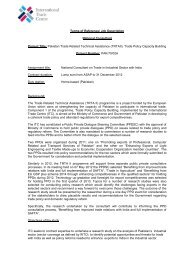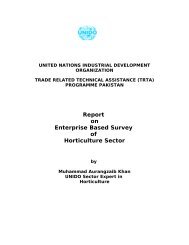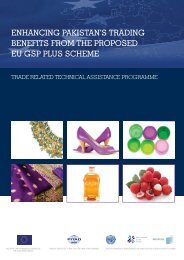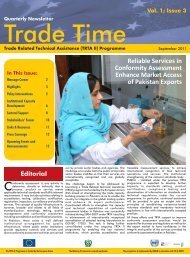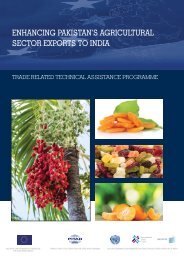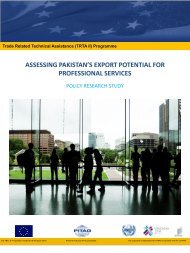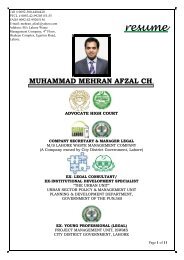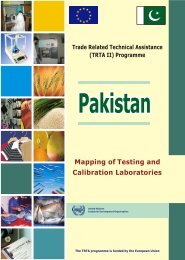Enhancing dairy sector export competitiveness - International Trade ...
Enhancing dairy sector export competitiveness - International Trade ...
Enhancing dairy sector export competitiveness - International Trade ...
You also want an ePaper? Increase the reach of your titles
YUMPU automatically turns print PDFs into web optimized ePapers that Google loves.
ENHANCING DAIRY SECTOR EXPORT COMPETITIVENESS IN PAKISTANIn view of the above obligation, Pakistan has set up the NAPHIS under the Ministry of National FoodSecurity and Research as the national enquiry point for domestic SPS measures and related issues. It isalso the focal point for CAC and the European Union Rapid Alert System for Food and Feed (RASFF). It isenvisaged that the organization will be transformed into a statutory regulatory body and would also be thefocal point for dissemination of information and issues on TBT.The Agreement on Technical Barriers to <strong>Trade</strong> (TBT)The TBT Agreement recognizes that technical regulations are important for many reasons includingconsumer safety, environmental protection, and national security. The problem arises with the fact thatthese regulations vary from country to country that makes trade difficult for producers and <strong>export</strong>ers. Also ifthese standards are set arbitrarily, they can make trade restrictive in the disguise of protectionism ofdomestic industries by member countries. The agreement therefore strives to ensure that these technicalregulations, standards, testing and certifications do not create unnecessary barriers to trade. Although itrecognizes the member countries’ rights to ensure domestic safety and protection, they are encouraged toadhere to international standards and follow the principle of non-discrimination amongst trading partners.For the sake of clarity, it may be noted that technical regulations and standards include the specificcharacteristics of a product in terms of its size, shape, design, functionality and performance and thesealso include the requirements of its labelling and packaging.The agreement is based on the following objectives:a. Protection of human safety and health, examples include equipping motor vehicles with seatbelts to minimize injury, labelling of cigarettes which indicate their harmfulness to health.b. Protection of animal and plant health and life by water, air and soil pollution so that they do notbecome extinct.c. Protection of the environment that may include recycling of paper and plastic products, levelsof carbon emissions etc.d. Prevention of deceptive practises by producers that includes provision of complete informationregarding the product to consumers in terms of its labelling and packaging requirements,measurements, classification and definition etc.The key features of the TBT Agreement are discussed as below:• Preparation, Adoption and Applications of Technical Regulations and Standards: The TBT Agreementunder Articles 2, 3 and 4 specifies a code of good practice for governments of member countries andalso non-governmental and industrial bodies to prepare, adopt, and apply the voluntary standards.<strong>International</strong>ly, over 200 standards-setting bodies apply this code.• Fair and Equitable Assessment: Article 5 of the agreement specifies that the procedures adopted bymember countries which determine the conformity of a product with relevant standards should be fairand equitable and discourage any methods that may provide domestic products with an unfairadvantage.• Mutual Recognition: The agreement encourages member countries to recognize each other’sprocedures that test the conformity of the product to relevant standards and technical regulations.Without this the product may be tested twice; once in the <strong>export</strong>ing country and then by the importingcountry. Article 2.7 also encourages member countries to accept equivalent technical regulations ofother members even if these differ from their own if the country feels satisfied that the regulationsadequately achieve the objectives of their own regulations.• Transparency: Article 10 of the agreement binds member countries to set up “National Enquiry Points”to disseminate information regarding domestic technical regulations and standards and to exchangeinformation with other member countries through the WTO procedure of notification of new andexisting regulations.60



